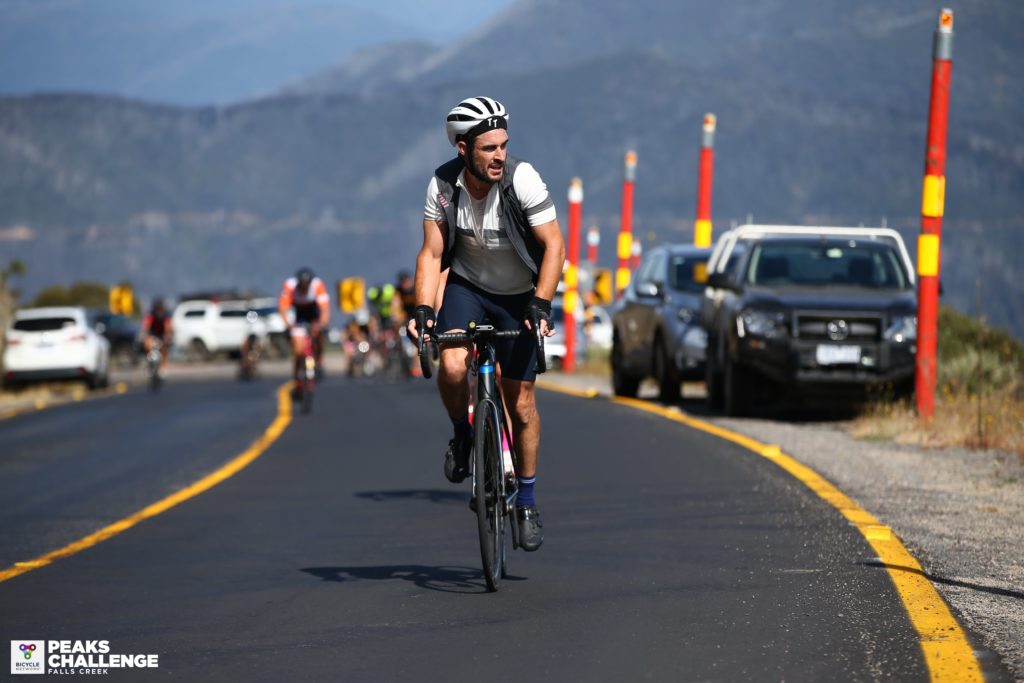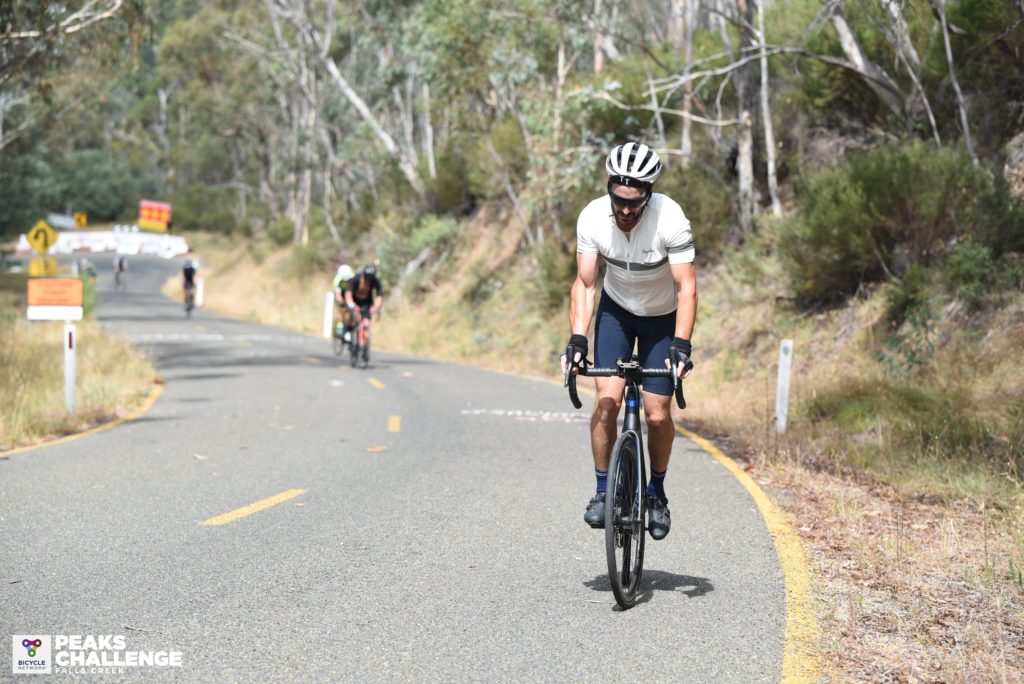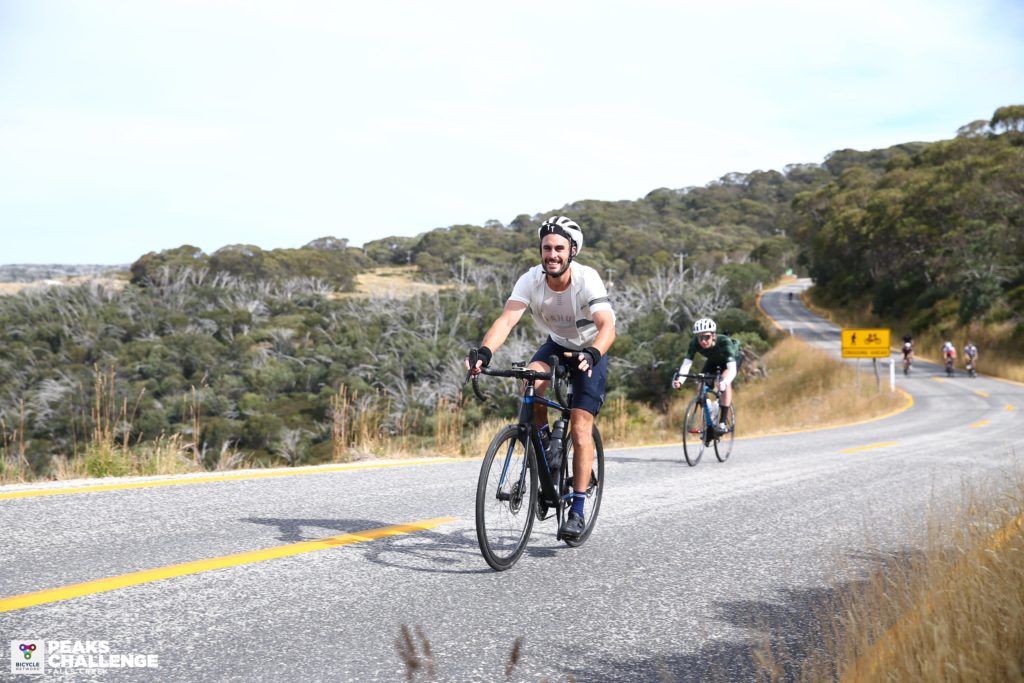In this article, Vincent Masci, a member of the Road Cycling Academy, will be sharing with you his wisdom / tips about one of Australia’s penultimate cycling events – Peaks Challenge. A monster 235 km ride, with a lazy 4000m + of climbing, in one of Australia’s most beautiful alpine areas. The below cycling tips will range from cycling nutrition, to pacing, to mindset. We’d like to thank Vince for putting this piece together and sharing his words of wisdom, especially for those tackling the event for the first time.
Over to Vince…
TIP ONE: Ride to your heart rate zones
I think a mistake I commonly make is getting caught up in the hype of these events. I see other people doing this as well, racing out of the blocks, committing too much, too early. Then paying for it later in the day.
I try to keep my heart rate in the range of the upper end of my Zone 2 to the middle of my Zone 3, backing it off as soon as I see it pushing anything more than that. For me (36/Male), that looks something like keeping my heart rate somewhere in the 150s and backing off as soon as I see it hit 160 or more.
While I’ll typically follow power in most training rides, 2-3 hours in length, when you’re talking about a 10 + hour ride, the ‘numbers’ focus should really shift to heart!
If you think you aren’t pushing hard enough early on, don’t worry, there’ll be plenty of time to push the higher ends of your heart rate later in the ride.
For Peaks Challenge, in particular, I know there’s a small climb on the Falls Creek descent and then the first major climb in Tawonga Gap. Trust me, you’ll be tempted to push on the pedals and gas it on fresh legs, but don’t get caught up, pace yourself, stay focused.

TIP TWO: Eat before you get hungry, drink before you get thirsty
Getting your nutrition right on these rides is just as important as your training leading up. Without an adequate intake of the right kind of food and fluids, you are going to fatigue, and all that endurance training you did in the lead up to this event will stand for absolutely nothing.
For Peaks Challenge, Bicycle Network put on an unbelievably well organised event and the food is amazing and frequent. You’ll find electrolytes at every rest stop and really good food! It’s great because it allows you to put some real food into your body over the course of the ride without having to carry too much on your bike, also eliminating the risk of running out.
Depending on how many stops you plan on making, make sure you are still carrying plenty of bars, gels, bananas, electrolytes or whatever you have used on your training rides in the lead up. That’s right, don’t start consuming anything new on event day (unless you have to). Gut training is critical.
Eat small amounts often at short intervals, and DEFINITELY before you feel hungry. Once you start to feel hungry, it’s probably already too late and you are going to rapidly start feeling fatigued, in which case, your only real option will be to spend some time resting.
On the Alpine Classic Ultimate ride earlier this year, I carried 5 Clif bars, 2 full packets of Clif Blok Gels and I stopped at every rest stop (aside from Anglers Rest) because I was eager to take on the back of the Falls climb. Although this ride was 320km and 6000m vertical, I was very confident – once I had hit the base of Falls – that I had eaten enough to get me to the top without having to worry about food. But I bonked hard and fast!
This was the fourth time I’d done back of Falls and easily the hardest because I hadn’t got my nutrition right.
Three quarters of the way up, I took a break at Raspberry Hill and stuffed down 4 bananas and a whole packet of raspberry lollies. My body was so hungry! I had to rest for some time before I felt adequate again, and only after the Falls Creek descent was I able to start putting a bit more power into the pedals.
Three personal nutrition anecdotes.
TIP THREE: Look for groups, pacers or buddy up
The great thing about events like Peaks Challenge is the volume of competitors as well as the event pacing groups, which in-turn, provides the opportunity to draft off others and save some energy, while keeping your speed in-check.
Like I said before, don’t focus too much on power, it’s conserving energy and speed that will define this event and the flattish sections between Tawonga Gap and Harrietville, Omeo, and back of Falls are the best opportunities you will have to use the legs of others to conserve some energy without compromising on time.
Having said this, the pacing groups can be problematic. My first Peaks, I left with the 10 hour group, but being a nervous / slow descender, I found myself riding with the 11 hour group through Mount Beauty only to burn a few tickets early on, attempting to catch back up to the 10 hour group on their way through to Harrietville.
Don’t get me wrong, the pacing groups are quick and thick. Wedge yourself in there nicely and you’ll be getting a nice tow, especially between Omeo and back of Falls where there can sometimes be a stiff headwind.
Don’t panic if you can’t find yourself a pacing group though, there’s generally plenty of riders that you’ll be able to sit in behind and grab a free ride, although you might have to be a bit more tactical after Omeo as riders can become a little sparse. The only caveat here is that you need to know when to let yourself get dropped.
While it can be all well and good to hold on for dear life on your local circuit, this is 236km, so you don’t want to let your heart rate creep into the higher zones. Know when to back off and enjoy some slower scenery alone.
TIP FOUR: Race prep, tapering and the night before
Not that this is my field of expertise, but here’s a few things I learnt the hard way preparing the week before an event;
– Don’t do a 200km ride the week before. If you are 7 days out from your event, your training is done. Pat yourself on the back, there’s nothing left you can do to make yourself stronger for this event other than rest. You can still do a long ride but don’t push the envelope, your prep here is done.
– Do continue whatever dietary plan or eating routine you were doing leading up until the event. Don’t stock up on salty, fatty or sugary foods the day or night before an event in an effort to calorie load. For some idiotic reason, last year, the night before Peaks Challenge I decided that potato chips and heavily salted barbecued sausages would be the ideal nutrition (when I had restricted myself from salty and sugary foods for the months leading up). That night my heart was racing due to a combination of nerves and the feast of salty foods. I managed to drift off after throwing down 2 beers at 2am which leads me to the next don’t:
– Don’t drink leading up to the event. I think this one goes without saying, but while it may calm your nerves it will destroy your quality of sleep, dehydrate you, and stunt whatever recovery your body wants to make up from your week of tapering.
– Optional, but I like to give up caffeine a week or two out from these type of events depending how serious I want to take it. Coffee is going to dehydrate me and make me need to get off the bike more.
The first year I did Peaks, given the cold weather, in nine and a half hours of riding, I did not need to get off the bike a single time. Not saying this is a great tactic, because I should have eaten more, but coffee can have a big impact on your need for nature breaks.

TIP FIVE: Break your ride down into smaller and manageable intervals
A ride like Peaks Challenge can feel overwhelming if you look at it as one giant 236km block with 4500m vert. I like to set myself checkpoints based around towns I’m coming into, climbs, rest stops, or if there isn’t any of them, I’ll set myself km based intervals based on how I’m feeling.
On a recent bike packing trip to Adelaide, on the days where towns were scarce and the weather was particularly hot, I would set myself a checkpoint to tick off every 50km and remember to eat and hydrate in each segment. Towards the end of the day, if I was starting to feel fatigued, I would change the checkpoint to every 20km and assess how I’m feeling. Sometimes stopping to recharge or sometimes powering on through.
Five blocks of 20km is mentally much easier for my mind to process than one block of 100km. On occasion I would go even further and count down every 5km inside the 20km block giving myself a series of much easier targets and victories to aim for.
With 3 Peaks, your checkpoints might be as follows:
– 41km Tawonga Gap Summit; First peak completed, give yourself a pat on the back. Have something to eat and focus on your descent down from the Tawonga Gap summit and then find a group to sit behind for a reasonably flat section of the Alpine Rd, from the bottom of the gap to Harrietville, and the base of Mt Hotham.
– 75km Base of Mt Hotham; Second checkpoint down and time for some serious climbing. You should be well hydrated, well fed, and have a gel or two into you by now for what is a pretty tricky Mt Hotham climb. A climb that I like to break down into a further three segments, of 10km each.
- The first 10km of Hotham is steep but manageable, be careful not to push too hard on the Meg. Keep your heart rate manageable.
- The second 10km of Hotham is a false flat and a great chance to have something more to eat and get hydrated again. Find a group if you like or take the time to refresh your legs in preparation for the final 10km.
- The final 10km gets very pinchy towards the business end, and this is what you want to have saved your energy for. CRB and Diamantina climbs feature gradients that are steep and long (10% plus). Keep your heart rate manageable and focus on getting to Dinner Plain.
– 117km Dinner Plain; Second peak conquered, Dinner Plain is one of the busier rest spots and can sometimes chew up a bit of your time, waiting to fill up your bottles and grabbing a feed. However, it’s a long way to Omeo with nothing much in-between and is not what you would consider a typical descent. With a couple of pinchy climbs thrown in the mix. This next section is where the legs begin to feel a bit heavy.
– 160km Omeo; Well on your way now, this is a great time to find a group to latch onto and tackle the rollers leading up to Anglers Rest and the back of Falls, beyond. Even though you are feeling fatigued, keep eating, make sure your bottles are full at Anglers Rest, and keep your heart rate manageable.
The weather often starts to warm after Omeo, so you might find yourself going through a lot more fluid. Be prepared!
– 200km Back of Falls & WTF; This is main reason why you’ve been conserving your energy all day. You should have reached well into your bag of tricks by now and stuffed down a few gels, plenty of hydration, something to eat, a red bull and whatever else you can find. No doubt about it, this climb is tough. I break this one into a further three segments as mentally, this is as challenged as you will be all day.
- The first 6km including WTF Corner are super slow. Don’t burn yourself, just grin and bear the grind. The first 6km are the hardest 6km you will do all day because there isn’t much rest, it’s basically 10% plus with no respite. I count down in 500m intervals and punch it out.
- Things ease up a little over the next 4km but you’ve still got some pretty painful grinding to get through. There’s some rest, but there’s still a steep grade and your legs are hurting. Count down every 500m and grind out the next 4km.
- The next 10km – 12km will still hurt but its manageable and the hardest part of the day is over, meaning pretty soon, you’ll be on the home straight. Focus on your next goal, finishing Peaks and start thinking about using up whatever energy your body has left. You want to leave nothing out there.
– 236km Falls Creek; Cross the finish line, have a bit of a cry and find yourself a beer.

Peaks Challenge Bonus Tip
Have fun. This is a fantastic weekend, one of my favourite weekends of the year. You are spending a weekend with fit, happy, like-minded individuals who are all there for the same healthy reason as you. To push themselves a little bit further.
Falls Creek is an amazing place this time of year, the cafes are buzzing, you’ll see endless bike porn of all varieties, and should you stop in the township of Bright on the way through, you’ll see why this is one of my favourite regions in Victoria to get away.
Take in the breath-taking views going up Hotham and remember to smile going up the back of Falls because you’ll have a beer in your hands soon enough and an indescribable satisfaction that you can only get from putting yourself this far out of your comfort zone.
If you aren’t signed up to Peaks Challenge this year and haven’t done it before, you should really consider it, or something similar in the near future. It really helps having a goal this substantial to give your training purpose and meaning.
I look forward to seeing you out on the course in a few week’s time.
Vincent Masci
Interested in following Vince’s path? Apply for the next intake of the Road Cycling Academy’s Uplevel Road Cycling Course here


Brilliant write up mate. Thank you.
Great post mate. Thanks!
Thanks for sharing your for experience. Lots of really good insight and advice – getting the nutrition right had been a focus and seems to be yours as well.
Great insight on sleep and caffeine as well… Should have read this sooner…
I am new to this site, Like what I am reading thus far.